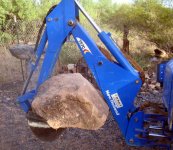MtnViewRanch
Elite Member, Advertiser
- Joined
- Mar 19, 2005
- Messages
- 10,671
- Tractor
- Mahindra 7520, Mahindra 3215HST, Case 580 extendahoe, Case 310 dozer, Parsons trencher, Cat D6,
All I can say is that I have a 7300lb tractor with a loader that weighs 2000lbs, that will lift 3900lbs to full height. If I want to lift that 3900lbs comfortably, I need ballast of some kind. I have all my tires filled and have 864lbs of wheel weights. the tractor will lift maximum weight with that, BUT, if I want to move that weight any distance, it is waaaaay easier , safer and more comfortable to do it with a 1000lb rear implement attached on the 3pt. So to get the best performance from my tractor for lifting and traction purposes, it is usually in the 12,000lb plus range.
I also have a 32hp tractor, and that tractor by far does it's best work while ballasted. Not that it would not do the work without ballast, but again with it ballasted it does the work faster, safer and easier than if it was not.
Just my experiences with my tractors.
I also have a 32hp tractor, and that tractor by far does it's best work while ballasted. Not that it would not do the work without ballast, but again with it ballasted it does the work faster, safer and easier than if it was not.
Just my experiences with my tractors.
Last edited:

